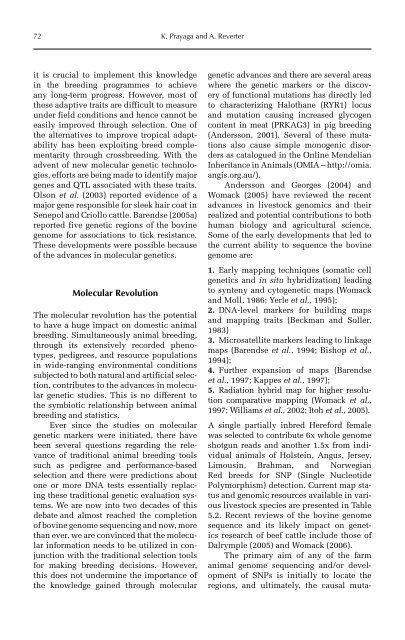Redesigning Animal Agriculture
Redesigning Animal Agriculture
Redesigning Animal Agriculture
You also want an ePaper? Increase the reach of your titles
YUMPU automatically turns print PDFs into web optimized ePapers that Google loves.
72 K. Prayaga and A. Reverter<br />
it is crucial to implement this knowledge<br />
in the breeding programmes to achieve<br />
any long-term progress. However, most of<br />
these adaptive traits are difficult to measure<br />
under field conditions and hence cannot be<br />
easily improved through selection. One of<br />
the alternatives to improve tropical adaptability<br />
has been exploiting breed complementarity<br />
through crossbreeding. With the<br />
advent of new molecular genetic technologies,<br />
efforts are being made to identify major<br />
genes and QTL associated with these traits.<br />
Olson et al. (2003) reported evidence of a<br />
major gene responsible for sleek hair coat in<br />
Senepol and Criollo cattle. Barendse (2005a)<br />
reported five genetic regions of the bovine<br />
genome for associations to tick resistance.<br />
These developments were possible because<br />
of the advances in molecular genetics.<br />
Molecular Revolution<br />
The molecular revolution has the potential<br />
to have a huge impact on domestic animal<br />
breeding. Simultaneously animal breeding,<br />
through its extensively recorded phenotypes,<br />
pedigrees, and resource populations<br />
in wide-ranging environmental conditions<br />
subjected to both natural and artificial selection,<br />
contributes to the advances in molecular<br />
genetic studies. This is no different to<br />
the symbiotic relationship between animal<br />
breeding and statistics.<br />
Ever since the studies on molecular<br />
genetic markers were initiated, there have<br />
been several questions regarding the relevance<br />
of traditional animal breeding tools<br />
such as pedigree and performance-based<br />
selection and there were predictions about<br />
one or more DNA tests essentially replacing<br />
these traditional genetic evaluation systems.<br />
We are now into two decades of this<br />
debate and almost reached the completion<br />
of bovine genome sequencing and now, more<br />
than ever, we are convinced that the molecular<br />
information needs to be utilized in conjunction<br />
with the traditional selection tools<br />
for making breeding decisions. However,<br />
this does not undermine the importance of<br />
the knowledge gained through molecular<br />
genetic advances and there are several areas<br />
where the genetic markers or the discovery<br />
of functional mutations has directly led<br />
to characterizing Halothane (RYR1) locus<br />
and mutation causing increased glycogen<br />
content in meat (PRKAG3) in pig breeding<br />
(Andersson, 2001). Several of these mutations<br />
also cause simple monogenic disorders<br />
as catalogued in the Online Mendelian<br />
Inheritance in <strong>Animal</strong>s (OMIA – http://omia.<br />
angis.org.au/).<br />
Andersson and Georges (2004) and<br />
Womack (2005) have reviewed the recent<br />
advances in livestock genomics and their<br />
realized and potential contributions to both<br />
human biology and agricultural science.<br />
Some of the early developments that led to<br />
the current ability to sequence the bovine<br />
genome are:<br />
1. Early mapping techniques (somatic cell<br />
genetics and in situ hybridization) leading<br />
to synteny and cytogenetic maps (Womack<br />
and Moll, 1986; Yerle et al., 1995);<br />
2. DNA-level markers for building maps<br />
and mapping traits (Beckman and Soller,<br />
1983)<br />
3. Microsatellite markers leading to linkage<br />
maps (Barendse et al., 1994; Bishop et al.,<br />
1994);<br />
4. Further expansion of maps (Barendse<br />
et al., 1997; Kappes et al., 1997);<br />
5. Radiation hybrid map for higher resolution<br />
comparative mapping (Womack et al.,<br />
1997; Williams et al., 2002; Itoh et al., 2005).<br />
A single partially inbred Hereford female<br />
was selected to contribute 6x whole genome<br />
shotgun reads and another 1.5x from individual<br />
animals of Holstein, Angus, Jersey,<br />
Limousin, Brahman, and Norwegian<br />
Red breeds for SNP (Single Nucleotide<br />
Polymorphism) detection. Current map status<br />
and genomic resources available in various<br />
livestock species are presented in Table<br />
5.2. Recent reviews of the bovine genome<br />
sequence and its likely impact on genetics<br />
research of beef cattle include those of<br />
Dalrymple (2005) and Womack (2006).<br />
The primary aim of any of the farm<br />
animal genome sequencing and/or development<br />
of SNPs is initially to locate the<br />
regions, and ultimately, the causal muta-










